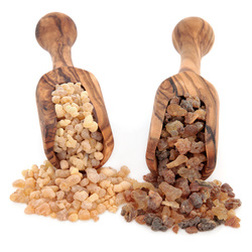
Both items were and are quite expensive and thus have been associated with royalty and wealth, although poorer people have used them as much as they could afford to. Ancient cities sometimes used incense as a type of air purifier. If you found yourself walking down the streets of imperial Rome you’d be pretty overwhelmed with the various stenches of garbage and sewage, but once in awhile, as you passed a statue of some emperor or god, you’d get a whiff of fragrant smoke, since incense burners were usually placed in front of them. The story is told that at the funeral of Sulla the dictator in 78 BC a whole statue of the deceased was made out of frankincense and other aromatics and set on fire to perfume the air during the ceremony. Alexander the Great apparently loved frankincense and was quite extravagant with it in his offerings at temples. His tutor disapproved, telling him that he should wait until he conquered the areas where it originated before using so much of it. So . . . of course Alexander did conquer those areas, and in an exquisitely fitting comeback he sent a huge amount of frankincense (and also quite a bit of myrrh) back to Macedonia with a message saying that the tutor now wouldn’t need to be so miserly in his dealings with the gods.
There are some very interesting biblical associations with these substances, the most obvious being that they were used for the incense burned in Israel’s tabernacle and later temple. Even more fitting, perhaps, is that both of these fragrances are only obtained when the trees that produce them are wounded; the process of slashing the bark so that the resins will ooze out is often called “bleeding the trees.” So they can be seen as symbols of suffering as well as of worship. Christians believe that the Old Testament book of Isaiah, chapter 53, gives a similar picture of the suffering Messiah:
Surely he took up our pain and bore our suffering, yet we considered him punished by God, stricken by him, and afflicted. But he was pierced for our transgressions, he was crushed for our iniquities; the punishment that brought us peace was on him, and by his wounds we are healed. We all, like sheep, have gone astray, each of us has turned to our own way; and the Lord has laid on him the iniquity of us all.
As you look at, listen or sing the words to many traditional carols you’ll see the idea of Christ’s coming to set men free from sin occurring over and over. There’s great joy in the present but great sorrow to come. I talked in an earlier post about the “bigger implications of the Christmas story,” and even here, in the list of the gifts given to the Christ child, those implications occur.
So what did Mary and Joseph do with the gifts of the Magi? We don’t really know. There is one possibility, though, that makes a lot of sense: the gold, at least, but possibly the other two items, were used to finance the trip to Egypt that they made in order to escape the Massacre of the Innocents, an event I have discussed quite thoroughly in this post. How else could they have made the journey? The Magi had no idea of all this as they opened their treasures and made their offerings. They did what they had come to do and left, vanishing from the record. Surely we can at least honor them by remembering their journey and sacrifice as we see the rows of “frankincense and myrrh” candles at the store!
©Debi Simons

